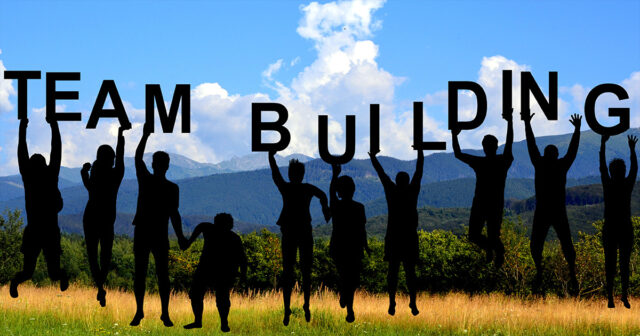
Team Spirit is the heartbeat of any productive environment. It’s the invisible force that binds individuals together, creating a synergy that propels teams toward their goals. In today’s fast-paced and dynamic workplaces, fostering team spirit is not just a feel-good factor but a necessity for achieving success.
A group that collaborates cohesively, communicates effectively, and trusts each other is better equipped to tackle challenges and seize opportunities. In this blog post, we will delve into the world of team-building activities that cater to various aspects of dynamics, ensuring a stronger, more engaged, and high-performing team.

Benefits of Strong Team Collaboration
The advantages of a well-collaborated team are manifold. From improved problem-solving abilities and heightened creativity to increased productivity and employee satisfaction, the benefits are undeniable. Groups that work harmoniously tend to share information freely, leading to faster decision-making and streamlined processes. Moreover, a united group can adapt to changes with agility, making them more resilient in the face of uncertainties. It’s not just about completing tasks; it’s about creating an environment where each member’s strengths are harnessed, leading to the greater accomplishment of shared goals.
Icebreakers: Fostering Team Cohesion

Breaking the ice is important at the beginning of every team’s journey. Activities that break the ice lay the stage for future masterpieces, much like the first strokes of a painter’s brush. These exercises might be straightforward, like “Two Truths and a Lie,” or more complex, like a retreat for development. The intention is to foster a laid-back environment where members may get to know one another outside of their own work contexts. Open communication and camaraderie, two key components of a strong spirit, are established via these activities.
Communication: Enhancing Information Exchange
Clear and efficient communication is the cornerstone of any successful team. Activities like “Broken Telephone” or “Storytelling Circles” are designed to highlight the importance of effective communication. Through these exercises, crew members learn to convey ideas concisely, listen actively, and ensure that messages are not lost in translation. These skills translate directly into the workplace, reducing misunderstandings and fostering a more collaborative environment.
Problem-Solving: Cultivating Collective Creativity

Problem-solving is the crucible where a group’s collective creativity ignites. Engaging in collaborative exercises like escape room challenges or group puzzles isn’t just about cracking codes; it’s about cracking open minds to innovative possibilities. These activities encourage diverse perspectives, inviting each member to contribute their unique insights. As the team navigates through challenges together, they learn the power of synergy – how combining different strengths leads to extraordinary solutions.
Through problem-solving activities, crews develop critical thinking, refine decision-making skills, and strengthen their ability to work harmoniously under pressure. It’s a crucible where individual brilliance melds into a blazing trail of collective creativity, propelling groups toward new heights of achievement.
Trust Building: Strengthening Interpersonal Relationships
Trust is the glue that binds groups together. Building and maintaining trust can be cultivated through activities like “Trust Falls” or “Team-building Workshops.” These experiences create opportunities for members to rely on each other, fostering mutual understanding and empathy. As trust grows, individuals become more comfortable sharing ideas, seeking help, and taking calculated risks. This foundation of trust extends beyond the office, contributing to healthier relationships among colleagues.
Diversity: Promoting Inclusivity Within the Team

The beautiful tapestry of diversity that binds teams together. A culture of inclusion is fostered through participating in events like “Cultural Exchange” and “Skill-sharing Sessions” that celebrate diversity. These encounters break down boundaries and build a deep appreciation of the individuality of each member. Recognizing differences is only one aspect of celebrating diversity; another is utilizing the strength of many viewpoints.
A rich tapestry of ideas emerges when groups learn to respect individual contributions, fostering creativity and collaboration. This inclusiveness leads to more empathy and respect among teammates, converting a group of individuals into a close-knit family. Crews that participate in diversity-promoting activities foster an environment where everyone’s voice is heard, strengthening their sense of belonging and teamwork.
Outdoor Activities: Refreshing Team Dynamics
Stepping out of the office and into the great outdoors can breathe new life into dynamics. Team-building activities like hiking, sports, or even outdoor team-building workshops provide a change of scenery and a break from routine. Being outside encourages informal interactions and helps members see each other in a different light. These experiences create lasting memories that contribute to stronger bonds back in the office.
Virtual Teams: Nurturing Team Spirit Remotely

Through creative exercises like online treasure hunts and virtual escape rooms, virtual crews create connections across disparate digital environments. Despite geographical separation, these events foster a sense of community. Collaboration projects and talent performances through video calls help to foster camaraderie by removing screen boundaries. These activities remind distant participants that they are essential by bringing actual relationships into virtual settings. As shared objectives and engaging interactions take precedence, distance becomes a minor technicality when personalized virtual group-building is adopted.
Fostering Continuous Improvement

The compass directing groups towards continual improvement is reflection. Crews analyze past experiences to shed light on potential future paths through exercises like “SWOT Analysis Workshops” and “Retrospective Meetings.” These meetings encourage a culture of growth by acknowledging successes and discussing failures. Group members collaborate, learning from one another’s viewpoints and improving their overall strategy.
As they develop based on self-evaluation, this reflective practice fosters flexibility. It is a dynamic cycle of assessment and modification that improves problem-solving, collaboration, and communication. With a clearer vision and a shared commitment to maximizing their collective potential, groups who embrace the mirror of reflection can shape their future.
Conclusion
In the complex landscape of modern workplaces, group spirit isn’t just a buzzword; it’s the driving force behind success. Engaging activities touch upon every facet of dynamics, from icebreakers that lay the foundation of camaraderie to trust-building exercises that strengthen interpersonal relationships. Effective communication, problem-solving skills, diversity celebration, outdoor experiences, and tailored activities for virtual groups all contribute to the thriving culture of collaboration. By engaging in these activities, teams forge unbreakable bonds that lead to higher productivity, increased job satisfaction, and a harmonious work environment.







